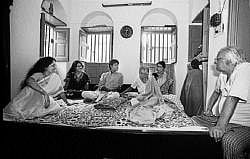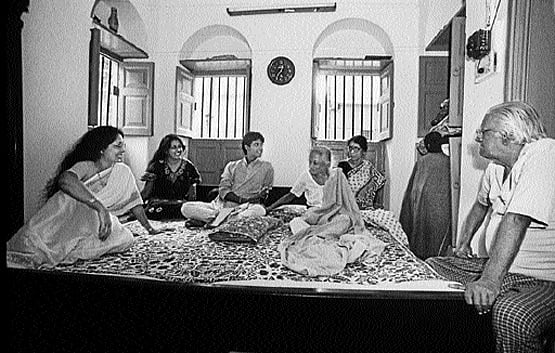

Photographer Kushal Ray’s Ladakh is not just about spectacular landscapes. Nor is it about the flora and fauna nurtured by its crisp mountain air.
If anything, it is about the human life that teems in the deep folds of its astonishing topography. “I have always been interested in looking for a spark of life in the ordinary,” says the photographer who turned fifty recently. He remembers peering at a copy of Van Gogh’s 1885 classic ‘The Potato Eaters’ as a youngster in his middle-class south Kolkata home. The life force of the people sharing a community meal of potatoes and little else in dark and grimy surroundings fascinated him. And it went on to shape Ray’s artistic sensibility as photographer, prompting him to seek out a flicker of life even amid the banal.
Today, his oeuvre on Ladakh documents the vibrant human life pulsating in the cracks and crevices of the enchanting valley. “On each of my four visits following the first one in 1987, I’ve tried to go back to the people I’ve captured on lens before,” says Ray, who has made lasting friendships in its streets and homes.
And so, the people in his photographs are able to rise above their anonymity to emerge as characters of flesh and blood. Welcoming him in their homes, they entrust their daily lives and philosophy candidly to his roving camera. In return for their open hospitality, Ray takes back their portraits as gifts on subsequent visits, getting an insider’s view of their homes and their lives, again and again.
The intimacy with his “regulars” in Ladakh has helped Ray find a much-needed “narrow focus” for his project: Blurred religious boundaries between the Muslims and Buddhists in the region. “Less than 300 km from a battle-scarred Kargil tainted by Muslim fundamentalism, the people of Leh share broadly similar cultures and a remarkably secular spirit.
The Muslims and Buddhists often wear the same kind of clothes and eat the same food. The burqa is not an absolute necessity for the Muslim women who sometimes merely keep the top of their heads covered unlike their Buddhist counterparts. Boys and girls going to school together present a picture of a liberal society,” says Ray, selecting pictures from fat folders all around him to illustrate his point.
The five trips to Ladakh have obviously been immensely gratifying for Ray and have yielded stacks of photographs. But for another less determined person in his place, his first visit might well have been his last. Then a sports journalist with ‘The Telegraph’ newspaper in Kolkata, all Ray had been able to afford in 1987 was a shoestring-budget trip to Ladakh. He came back with not just several reels of photographs but also the most appalling and obdurate sunburns that threatened to turn into skin cancer unless treated immediately. Staying in unhygienic surroundings in a low-cost guesthouse had also taken its toll: he contracted tuberculosis sometime later.
The disease was to hound him again in a much graver form a few years later. Ray had lost his parents early and had no one in his extended family to turn to during this particularly debilitating bout of resistant tuberculosis. He moved into his friend Apurba’s home in a middle-class south Kolkata neighbourhood. Apurba’s aunt Manju Chatterjee, a retired lecturer of a Kolkata college and the head of the family, welcomed him with open arms.
Ray spent the next four years in the Chatterjee home, at first recuperating from his illness, and later simply savouring the inclusive spirit of the household even after he was well enough to move back into his own family home only a shout away.
This association gave birth to his other important body of work, entitled ‘Family Matters’, which spans black and white photographs of the Chatterjees taken over the next ten years. The family reveals itself to him, cooperating, almost collaborating, with him in the documentation of its fortunes and failures till Manju’s demise, which sounds the death knell for its joint family structure.
Now a book project to be published by the Delhi-based Neogy Books, ‘Family Matters’ is the basis of author Kunal Basu’s next work, ‘Intimacies’. The collaboration between Basu and Ray is being coordinated by art curator Ina Puri.
Photographing the Chatterjees was no idle pastime; it was a conscious artistic decision from the beginning. ``I was inspired by photographer Dayanita Singh’s remarkable family portraits and decided to train my focus on this ordinary middle-class Kolkata family into which I had been accepted. I was an insider and an outsider at the same time here, enjoying the affection of matriarch Manju Chatterjee and her mother who showered me with the love I had always craved but never got from my own grandmother,” says Ray.
By 2007 Ray felt that his family project was complete and he was ready to approach a publisher to produce a book with a happy ending. But this was not to be. Manju fell ill and was diagnosed with cancer. She battled with the disease for the next ten months, during which Ray was her main caregiver. Encouraged by Manju, he captured her determined but fruitless fight for life lovingly, caressingly, even as he accompanied her on her incessant visits to doctors and hospitals and administered her medicines till the end.
“Life” has always been the operative word in Ray’s scheme of things. “When I started my family project, I never thought my photographs would be valued as art some day. I feel that life is much more significant than art. Art works for me only if it portrays life,” says Ray, who swears by the genius of American photographer W. Eugene Smith, writer Saul Bellow and painter Edward Monk, among others.
Ray whose early influences included Raghubir Singh and Raghu Rai, chose to seek his own vocabulary early on in his career. “In a conscious departure from the works of other photographers, I’ve always tried to offer new perspectives,” he says.
It is this freshness of approach that pervades his works with rare significance.
